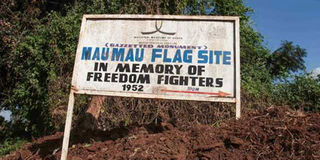Little-known Mau Mau uprising memorial site

A signage at the Mau Mau flag site at Ruring'u in Nyeri. PHOTO | JOSEPH KANYI | NATION MEDIA GROUP
What you need to know:
- Freedom fighters assembled in the area on July 6, 1952, and declared war against colonialists.
- The site was gazetted by the National Museums of Kenya in 2001 and in 2009 two small concrete slabs were built to mark the place.
One is written ‘Mau Mau flagsite in memory of freedom fighters 1952-1957 and the other ‘Kigongona gia kiririkano’ (tabernacle for commemoration) 1952-1963.
Also a short metallic post was set up, an indication a flag would be hoisted later.
Nyeri was the stronghold of the Mau Mau uprising, and there are many reminders of the war for visitors to see.
Among the historic locations associated with the fight for freedom is the Mau Mau flag site near Ruring’u Stadium just opposite Nyeri Museum formerly the ‘native law court.’
The site is where freedom fighters assembled from the forest on July 6, 1952, to declare war against the colonial administration, its loyalists and agents.
Following the declaration of armed war against the British Empire in October 1952, three months later the British also declared a state of emergency and began moving its army into the country mostly in Central Kenya highlands. The state of emergency lasted until 1960, leaving more than 10,000 Mau Mau fighters and dozens of White Settlers dead.
On December 19, 1963, the Mau Mau fighters assembled at Ruring’u stadium again, on the spot where they had declared the war, and surrendered their arms, signalling the end of the uprising.
Both meetings were led by Prime Minister Jomo Kenyatta. The Mau Mau fighters, mostly drawn from Gikuyu, Embu and Ameru communities, were operating inside neighbouring dense forests such as Aberdare and Mt Kenya.
“In 1952, [Jomo] Kenyatta led the fighters in declaring the war. He asked them: ‘If I hold the bull’s horns, will you be ready to endure the kicks?’ They said yes and the struggle for freedom proceeded,” narrates Ms Janerose Mukiri, a curator posted at the Nyeri Museum by the National Museums of Kenya (NMK).
The site was gazetted by the NMK in 2001 and in 2009 two small concrete slabs were built to mark the place.
One is written ‘Mau Mau flagsite in memory of freedom fighters 1952-1957 and the other ‘Kigongona gia kiririkano’ (tabernacle for commemoration) 1952-1963. Also a short metallic post was set up, an indication a flag would be hoisted later.
However, the site that serves as a memorial for fallen freedom heroes is abandoned, unkempt and hardly has visitors. It is bushy, and unkempt though hosting Nyeri Town Constituency Development Fund.
Ms Mukiri says they occasionally get a few international visitors, mostly researchers and academicians interested in Mau Mau war.
On the other side of the road, the museum, which is housed in a ‘native law court’, is well maintained. Ms Mukiri says the house is filled with items related to the Emergency war such as the colonial shields, helmets and colonial government’s movement ‘Pass books’.
Also there are bricks produced by detainees at Aguthi Works Camp now the Kangumbiri Girls school.
“We do not charge anything and this is the reason teachers and parents should be bringing pupils to learn history of their country’s liberalisation,” says Ms Mukiri.





